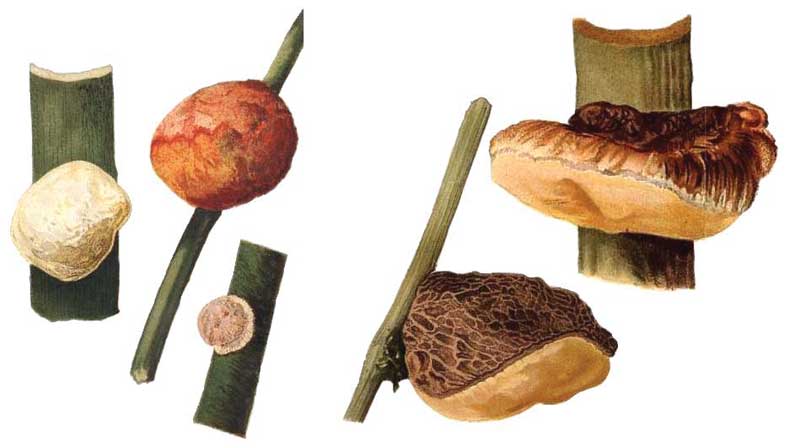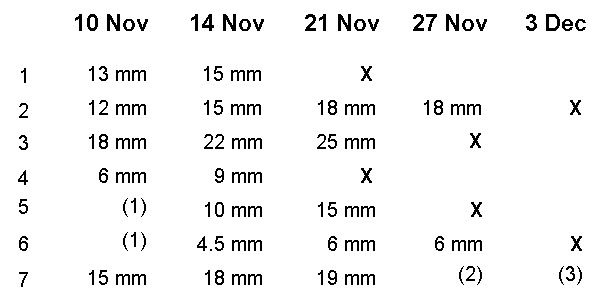Case StudiesMonkey foodAt least 22 primate species have been seen to eat fungi. Included in these 22 are gorillas, bonobos, macaques, vervet monkeys, mangabeys, colobines, marmosets and lemurs. However the question of fungus consumption by primates has been little studied, with most reports being anecdotal. Also poorly known is which fungi the primates eat, few fruiting bodies having been identified beyond descriptive term's such as "bracket fungus" or "mushroom". The available evidence suggests that, in general primates spend little time searching for fungi, with less than 5% of feeding time devoted to fungus eating, or mycophagy. However, there are exceptions and one of these is Goeldi's monkey (Callimico goeldii), a small monkey of the Amazon basin. An adult weighs about half a kilogram. Goeldi's monkeys eat the fruiting bodies (or sporocarps) of four fungi on a regular basis, the four species being Auricularia auricula, Auricularia mesenterica, Ascopolyporus polychrous and Ascopolyporus polyporoides. Auricularia sporocarps are rubbery, typically somewhat ear-shaped when fresh and the genus is found worldwide. Some species of this genus are commercially grown for human consumption in various Asian countries. The genus Ascopolyporus is found in Central and South America and the sporocarps are bulbous to hoof-shaped, giving a superficial resemblance to various polypores and hence the explanation for the latter part of the genus name. However, they are ascomycetes of the broad "flask fungi" group, the asci being produced in miniature chambers (or perithecia) on the sporocarps' lower surfaces. There's a little more about the genus Ascopolyporus further on. When compared to other foods the fungal sporocarps appear sporadically and with a patchy distribution, so the monkeys must travel widely in search of sporocarps. It is also possible that fungi would be low in accessible nutrients. There have been few studies on the physiology of primate mycophagy, but investigations on other animals have shown that sporocarps are difficult to digest and that animals without foregut fermentation systems would extract at most little protein and energy from the sporocarps. Goeldi's monkeys lack foregut fermentation so why do these monkeys seek out fungi? One possibility is that fungi provide important vitamins or minerals. The monkeys eat fungi year round but fungi are eaten much more during the early part of the dry season when fruit is rarer. Over a whole year Goeldi's monkeys spend about 29% of their feeding time eating fungi but during the dry season up to 63% of the feeding time can be spent on mycophagy. The fungi therefore appear to be a fall-back food, though it is clear that the monkeys do deliberately seek out the fungi, rather than just eating them as they come across them by chance. Still, why not spend more time looking for the scarce fruit during the early part of the dry season? There is considerable competition for fruit (especially during the dry season) and Goeldi's monkeys typically lose out to other monkeys in aggressive encounters. The fungi eaten by Goeldi's monkeys are much more abundant in the forest understorey than in the middle levels and forest canopies, where the other monkeys spend most of their time. Zoologists studying Goeldi's monkeys have reported seeing no competitions with other monkeys for fungal sporocarps, so the heavy reliance on fungi by Goeldi's monkeys would reduce feeding competition. The researchers suggested that reliance on low-nutrient fungi would help explain the fact that Goeldi's monkeys have a lower population density and much larger home ranges than those of other, similar-sized monkeys in the same forest. It has also been suggested that Goeldi's monkeys may have some other adaptation, yet unknown, to help them digest fungal sporocarps so further studies of this monkey would be very worthwhile. In the USA annual mushroom consumption averages out at about 1.9 kilograms (fresh weight) per person, while for Goeldi's monkeys the average annual fungal consumption is about 6.1 kilograms (fresh weight) per monkey. AscopolyporusThe following illustrations are from Alfred Möller's Phycomyceten und Ascomyceten. Untersuchungen aus Brasilien, published in 1901 by Verlag von Gustav Fischer in Jena. It was in that book that Möller gave the first description of the genus Ascopolyporus and of the species Ascopolyporus polychrous and Ascopolyporus polyporoides. He noted that the sporocarps are fleshy or gelatinous, are found on various bamboos and can grow to four centimetres in diameter (Ascopolyporus polychrous) or seven centimetres (Ascopolyporus polyporoides). In the image, the trio on the left belong to polychrous and the pair on the right to polyporoides. Going from left to right the diameters of the sporocarps featured here were 30, 35, 15, 60 and 60 millimetres. Möller noted that the sporocarps of Ascopolyporus polychrous had a weakly sweetish taste. Möller recorded the following observations about the growth of seven Ascopolyporus polychrous sporocarps. The measurements given are diameters and a bold X indicates that on the given date the sporocarp was missing. Notes:
He wrote that the sporocarps released spores in amazing quantities. When observed in a protective container this could be seen this easily, the spores falling like a grey cloud. He left a glass microscope slide under one sporing specimen for a week and found a spore deposit a half millimetre thick. After sporing the sporocarps usually became wrinkled and noticeably shrunken. Recent work has produced strong evidence for Ascopolyporus being parasitic on scale insects that in turn are parasitic on the bamboo. When the authors of the first of the papers listed below sectioned some Ascopolyporus fruiting bodies they found remnants of scale insects near the fungus/bamboo junction. As well as additional physical evidence of scale insects, DNA analysis showed Ascopolyporus to be a very close relative of a fungus known to be a scale insect parasite. References
|
![An Australian Government Initiative [logo]](/images/austgovt_brown_90px.gif)



